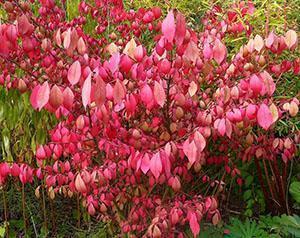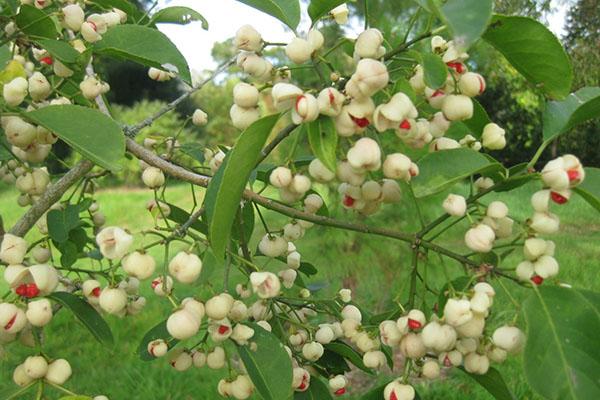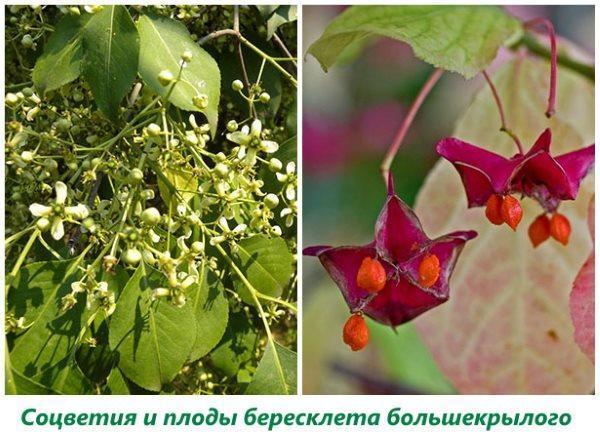Photos and descriptions of common species and varieties of euonymus
 Unlike other ornamental plants, which lose their attractiveness by the fall, euonymus decorate the site before snow falls or all year round. In nature, there are more than two hundred of these deciduous and evergreen shrubs or trees. Wild varieties of euonymus are most common in Asia; for several dozen species, the Old World, including the European part of Russia, is homeland. There are aboriginal euonymus on the shores of North America.
Unlike other ornamental plants, which lose their attractiveness by the fall, euonymus decorate the site before snow falls or all year round. In nature, there are more than two hundred of these deciduous and evergreen shrubs or trees. Wild varieties of euonymus are most common in Asia; for several dozen species, the Old World, including the European part of Russia, is homeland. There are aboriginal euonymus on the shores of North America.
Considering the photo of euonymus during flowering, it is difficult to imagine that the plants are classified as ornamental crops and can become an adornment of any park, garden or personal plot. The main treasure of euonymus is not tiny brownish or greenish flowers, but foliage of the most amazing colors and bizarre fruits, sometimes remaining on the branches even in the winter months.
Smooth leaves, depending on the species and variety, can be densely green or variegated. And by the fall, the foliage transforms, becoming purple, bronze, yellow or even white. No less amazing are the fruit-boxes, which, as they ripen, turn into burgundy, yellow, pink or scarlet tones. Inside the fruit are seeds surrounded by an equally bright dense pulp.

But even with a close relationship, they are strikingly different from each other. Descriptions and photos of all types of euonymus, adapted to Russian conditions, are a good help in choosing the best specimens for landscaping a house and a plot.
Large-winged euonymus (Euonymus macropterus)
 Among the numerous Asian species, the big-winged euonymus stands out for its large capsule fruits, which, when ripe, become densely crimson and effectively open, thanks to the wings up to 1.5 cm long, turning into a kind of bright flower. As you can see in the photo of the euonymus, seeds are attached to the inner side of the fruit, hidden under an orange seed flower.
Among the numerous Asian species, the big-winged euonymus stands out for its large capsule fruits, which, when ripe, become densely crimson and effectively open, thanks to the wings up to 1.5 cm long, turning into a kind of bright flower. As you can see in the photo of the euonymus, seeds are attached to the inner side of the fruit, hidden under an orange seed flower.
In the Far East, the homeland of the plant, this species is large deciduous trees up to 9 meters, but in the middle lane the crown height does not exceed 3 meters, and the euonymus looks like a large bush.
Small greenish flowers of the big-winged spindle tree appear in May and are collected in voluminous branched inflorescences. Seed ripening begins in September; a little later, the color of the smooth ovoid-pointed foliage of the plant also changes. The decorative effect is preserved until a permanent snow cover is established.
Japanese spindle tree (Euonymus japonicus)
 On the Japanese islands, in China and in Korea, another species of euonymus grows with oval dense leaves and orange seeds in neat pink boxes. This is a Japanese euonymus, reaching a height of 2–8 meters in adulthood.
On the Japanese islands, in China and in Korea, another species of euonymus grows with oval dense leaves and orange seeds in neat pink boxes. This is a Japanese euonymus, reaching a height of 2–8 meters in adulthood.
Plants prefer partial shade, easily tolerate a lack of moisture, and in the second half of May they reveal nondescript whitish flowers with a sour smell. Fruits ripen in autumn.
This type of euonymus is popular as an ornamental plant in many Asian countries, the USA and Europe. For gardening, dwarf and small-leaved forms, as well as numerous original varieties, have been bred.
 Dwarf Japanese euonymus of the Microphyllus variety is used to create hedges and dense borders. The plant tolerates even extensive pruning and easily restores its decorative effect.
Dwarf Japanese euonymus of the Microphyllus variety is used to create hedges and dense borders. The plant tolerates even extensive pruning and easily restores its decorative effect.
Cultivars with variegated or yellow leaves also quickly became popular all over the world, they adapt well to all types of soil and are unassuming to care for. An example of a variegated plant is a photo of a spindle tree of the Ovatus Aureus variety with foliage, on which areas of green and bright yellow coexist.
Warty euonymus (Euonymus verrucosa)
 Warty euonymus is one of the indigenous Russian species that can be easily found in the lower layer of deciduous or light coniferous forests. In nature, shade-tolerant plants can reach a height of 6 meters, but more often they look like bushes no higher than 1.5–2 meters.
Warty euonymus is one of the indigenous Russian species that can be easily found in the lower layer of deciduous or light coniferous forests. In nature, shade-tolerant plants can reach a height of 6 meters, but more often they look like bushes no higher than 1.5–2 meters.
In the photo of the euonymus, convex growths are clearly visible, covering all the shoots of the plant. Thanks to these formations, similar to warts, the species got its name.
Blossoming of brownish flowers, kept on long petioles, begins in late spring and lasts about a month. Pink fruits with shiny seeds, covered with red-brown seedlings, adorn the bushes from August to stable cold weather. Plants with excellent winter hardiness are suitable for arranging hedges, single and group plantings. This is one of the most affordable and unpretentious types of euonymus, which has been used in landscape design for over 40 years.
European spindle tree (Euonymus europaea)
 Another species of euonymus that is available and often found in its natural habitat grows in the European part of Russia, as well as in the Caucasus and Crimea. Unlike the previous species, the European euonymus is light-requiring and prefers to settle in deciduous forests.
Another species of euonymus that is available and often found in its natural habitat grows in the European part of Russia, as well as in the Caucasus and Crimea. Unlike the previous species, the European euonymus is light-requiring and prefers to settle in deciduous forests.
Under natural conditions, adult specimens reach 6 meters in height, they can look like a small tree or a spreading bush. Plants are easily formed and adapt to urban conditions, so they have long been used for landscaping a variety of objects.
Flowering lasts from June to July, and in the second half of August, the fruits that appear on the branches are painted in maroon and pink tones. The seeds are completely hidden in the tissue of the orange seed plant. The plants in the photo, like all types of euonymus, retain their fruits until winter. And in the fall, besides them, the bushes are decorated with purple foliage.
 Today, gardeners have at their disposal not only traditional plants, but also specially bred forms, differing in crown and foliage color. If you want to plant European euonymus on your site, you should pay attention:
Today, gardeners have at their disposal not only traditional plants, but also specially bred forms, differing in crown and foliage color. If you want to plant European euonymus on your site, you should pay attention:
- for specimens of pendula with weeping crown;
- small or even nana, that is, dwarf plants;
- especially decorative forms of intermedia;
- on a variety of euonymus with yellow-green aucubaefolia, purple atropurpurea or silvery-green argenteo-variegata foliage.
Dwarf spindle tree (Euonymus nanus)
 In the southern regions of Europe, in the Caucasus, as well as in certain regions of China, there is a wild dwarf spindle tree. Unlike all types of euonymus, the photo is really small. Its height does not exceed 1 meter, and thanks to the rapidly rooting shoots, the shrub often takes on a creeping shape. Thin green shoots are covered with narrow lanceolate leaves up to 4 cm in length.
In the southern regions of Europe, in the Caucasus, as well as in certain regions of China, there is a wild dwarf spindle tree. Unlike all types of euonymus, the photo is really small. Its height does not exceed 1 meter, and thanks to the rapidly rooting shoots, the shrub often takes on a creeping shape. Thin green shoots are covered with narrow lanceolate leaves up to 4 cm in length.
 The flowers, like other varieties of euonymus, are very small and hold on elongated purple, brown or green peduncles. Flowering lasts less than a week. If the fruit manages to ripen in the middle lane, brown-red seeds in orange seedlings appear from the capsule.
The flowers, like other varieties of euonymus, are very small and hold on elongated purple, brown or green peduncles. Flowering lasts less than a week. If the fruit manages to ripen in the middle lane, brown-red seeds in orange seedlings appear from the capsule.
Winged Euonymus (Euonymus alatus)
 Large plants ranging in height from 2 to 4 meters in nature can be seen in the Russian Far East, Sakhalin, as well as in other countries of this region.A distinctive feature of the winged euonymus is the unusual shape of branches with flat longitudinal formations on the bark, resembling lobes or wings.
Large plants ranging in height from 2 to 4 meters in nature can be seen in the Russian Far East, Sakhalin, as well as in other countries of this region.A distinctive feature of the winged euonymus is the unusual shape of branches with flat longitudinal formations on the bark, resembling lobes or wings.
Greenish flowers, opening at the end of May, are combined in small inflorescences of three. Fruit winged euonymus when ripe, they acquire a bright scarlet color, the capsule valves are dark, almost brown, very small.
 Under natural conditions, the plant is extremely unpretentious, easily tolerates frosts, is not afraid of drought and shading, but grows better in well-lit areas.
Under natural conditions, the plant is extremely unpretentious, easily tolerates frosts, is not afraid of drought and shading, but grows better in well-lit areas.
Maak's eonymus (Euonymus maackii)
 Another indigenous Russian species of spindle tree, in the photo, grows in Eastern Siberia, Primorye, and is also found in the northeast of China.
Another indigenous Russian species of spindle tree, in the photo, grows in Eastern Siberia, Primorye, and is also found in the northeast of China.
Adult specimens, depending on conditions and care, grow up to 2-8 meters. In autumn, this kind of euonymus amazes the audience with bunches of graceful pink bolls on long peduncles and large, up to 8 cm, pink-purple foliage.
American euonymus (Euonymus americanus)
 This kind of spindle tree at home, in the eastern states of the United States, is called a strawberry bush or "broken heart."
This kind of spindle tree at home, in the eastern states of the United States, is called a strawberry bush or "broken heart."
Mature deciduous, forms a bush up to two meters high. Shoots are thin, green or grayish brown. Single greenish or brownish-pink flowers form in the leaf axils. The leaves are dense, oval, with a serrate edge and an even green color.
Unlike all types of euonymus, in the photo of an American plant, the rough surface of a dense leathery capsule is clearly visible. Inside the carmine-colored fruit, 4 seeds are hidden in orange seedlings.
Wilson's euonymus (Euonymus myrianthus)
 A rare but very decorative species of euonymus is found in nature in western China, and was brought to Europe in 1908 by Ernest Wilson, a famous botanist and plant lover. As you can see in the photo of the euonymus, its fundamental difference is the yellow color of the seed bolls, which gives a bush or a low tree a very elegant, unusual look.
A rare but very decorative species of euonymus is found in nature in western China, and was brought to Europe in 1908 by Ernest Wilson, a famous botanist and plant lover. As you can see in the photo of the euonymus, its fundamental difference is the yellow color of the seed bolls, which gives a bush or a low tree a very elegant, unusual look.
Fortune's eonymus (Euonymus fortunei)
 Spindle tree of Chinese origin became known in Russia at the beginning of the last century, when the first specimens of the shrub were brought to the parks of the Black Sea coast of the Caucasus and Crimea. Today, Fortune's euonymus is at the peak of popularity, the reason for which is not only the pronounced decorativeness of plants, but also their diversity and endurance. This is a rare species of euonymus that remains evergreen and survives in Russian winters.
Spindle tree of Chinese origin became known in Russia at the beginning of the last century, when the first specimens of the shrub were brought to the parks of the Black Sea coast of the Caucasus and Crimea. Today, Fortune's euonymus is at the peak of popularity, the reason for which is not only the pronounced decorativeness of plants, but also their diversity and endurance. This is a rare species of euonymus that remains evergreen and survives in Russian winters.
In addition to the traditional form of a plant with lanceolate leaves, as in the photo of euonymus, and small white-red fruits, there are numerous creeping varieties. It is they who are of interest to Russian lovers of decorative cultures.
Fortune's euonymus has a mass of small-leaved and variegated forms that do not bloom, but winter well and reproduce vegetatively.
The flowers are small greenish-white, the capsule fruits are also smaller than those of other species. In shape, they are flattened-spherical, wingless. In the middle lane and to the north, only creeping forms are stable.
 For example, a variety of euonymus fortunei var. radicans is a fast-rooting, climbing or creeping small shrub suitable for planting as a curb or cover plant.
For example, a variety of euonymus fortunei var. radicans is a fast-rooting, climbing or creeping small shrub suitable for planting as a curb or cover plant.
 Emerald Gaiety, an euonymus forchun with a growth of only 30 cm, simply cannot be overlooked due to its bright oval foliage with a contrasting white edging. This color is typical for summer, by autumn the evergreen euonymus becomes pink-purple.
Emerald Gaiety, an euonymus forchun with a growth of only 30 cm, simply cannot be overlooked due to its bright oval foliage with a contrasting white edging. This color is typical for summer, by autumn the evergreen euonymus becomes pink-purple.
 The spectacular and very unassuming fortune euonymus Emerald Gold is another variegated variety, but already with yellow-green foliage. The maximum plant height does not exceed 50 cm, but tenacious shoots actively grow and form a crown up to one and a half meters wide.
The spectacular and very unassuming fortune euonymus Emerald Gold is another variegated variety, but already with yellow-green foliage. The maximum plant height does not exceed 50 cm, but tenacious shoots actively grow and form a crown up to one and a half meters wide.
 Harlequin's spindle tree is even more decorative than previous varieties of this amazing plant. Its young foliage is almost white.Greenery is present on it in the form of small chaotic spots. Only when it grows up, it acquires a more traditional color, but the light border still remains.
Harlequin's spindle tree is even more decorative than previous varieties of this amazing plant. Its young foliage is almost white.Greenery is present on it in the form of small chaotic spots. Only when it grows up, it acquires a more traditional color, but the light border still remains.
Small-leaved euonymus forchun Minimus is one of the smallest and most graceful varieties. Its height is only 15 cm, but it is impossible to pass by it. Bright, rounded leaves are eye-catching in summer and winter.
 In the spectacular Sunshine euonymus, yellow is the main color of the small oval-pointed foliage. The plant perfectly holds its shape, lends itself to forming and will become an original decoration of a living border, flower garden or alpine slide.
In the spectacular Sunshine euonymus, yellow is the main color of the small oval-pointed foliage. The plant perfectly holds its shape, lends itself to forming and will become an original decoration of a living border, flower garden or alpine slide.